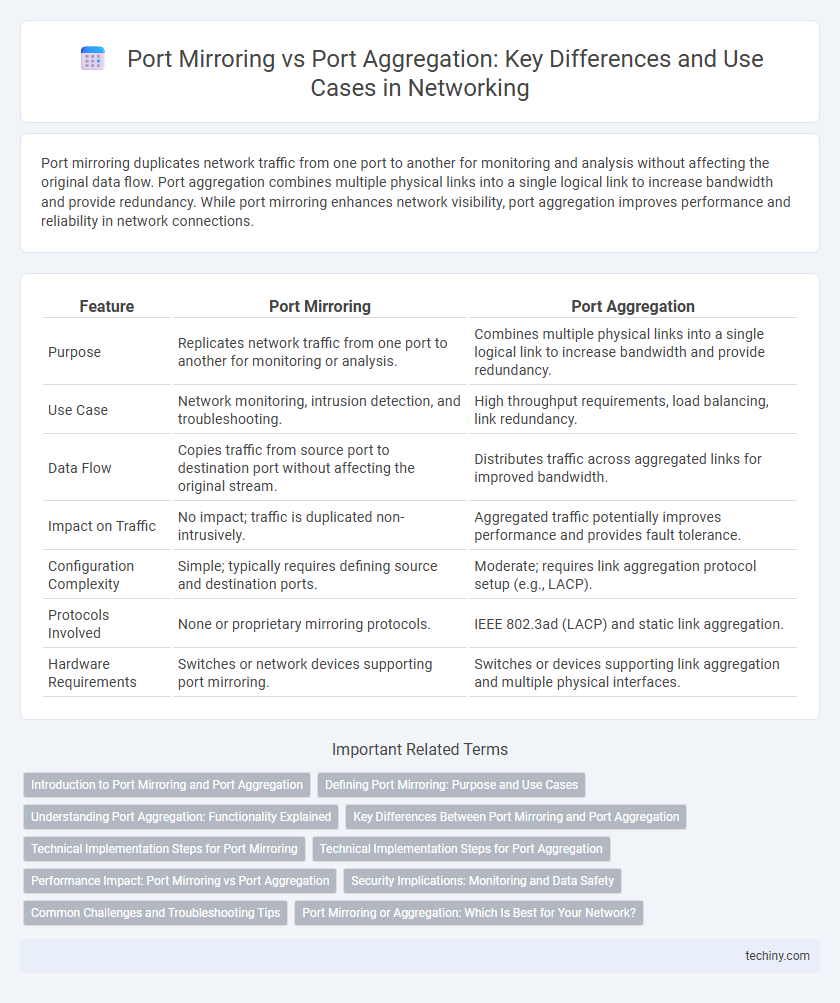Port mirroring duplicates network traffic from one port to another for monitoring and analysis without affecting the original data flow. Port aggregation combines multiple physical links into a single logical link to increase bandwidth and provide redundancy. While port mirroring enhances network visibility, port aggregation improves performance and reliability in network connections.
Table of Comparison
| Feature | Port Mirroring | Port Aggregation |
|---|---|---|
| Purpose | Replicates network traffic from one port to another for monitoring or analysis. | Combines multiple physical links into a single logical link to increase bandwidth and provide redundancy. |
| Use Case | Network monitoring, intrusion detection, and troubleshooting. | High throughput requirements, load balancing, link redundancy. |
| Data Flow | Copies traffic from source port to destination port without affecting the original stream. | Distributes traffic across aggregated links for improved bandwidth. |
| Impact on Traffic | No impact; traffic is duplicated non-intrusively. | Aggregated traffic potentially improves performance and provides fault tolerance. |
| Configuration Complexity | Simple; typically requires defining source and destination ports. | Moderate; requires link aggregation protocol setup (e.g., LACP). |
| Protocols Involved | None or proprietary mirroring protocols. | IEEE 802.3ad (LACP) and static link aggregation. |
| Hardware Requirements | Switches or network devices supporting port mirroring. | Switches or devices supporting link aggregation and multiple physical interfaces. |
Introduction to Port Mirroring and Port Aggregation
Port Mirroring, also known as SPAN (Switched Port Analyzer), duplicates network traffic from one port to another for monitoring and analysis, enabling administrators to troubleshoot and secure networks without interrupting data flow. Port Aggregation, often implemented through protocols like LACP (Link Aggregation Control Protocol), combines multiple network connections into a single logical link to increase bandwidth and provide redundancy. Both techniques optimize network performance but serve distinct purposes: Port Mirroring enhances visibility while Port Aggregation improves throughput and reliability.
Defining Port Mirroring: Purpose and Use Cases
Port mirroring is a network monitoring technique used to copy and forward traffic from one or more source ports to a designated destination port for analysis. Its primary purpose is to facilitate real-time network diagnostics, performance monitoring, and intrusion detection without impacting the original data flow. Common use cases include troubleshooting network issues, capturing packets for security audits, and monitoring bandwidth usage.
Understanding Port Aggregation: Functionality Explained
Port aggregation, also known as link aggregation, combines multiple network connections into a single logical link to increase bandwidth and provide redundancy. This functionality optimizes data flow by distributing traffic across aggregated ports, enhancing network performance and reliability. It differs from port mirroring, which duplicates traffic for monitoring rather than combining bandwidth.
Key Differences Between Port Mirroring and Port Aggregation
Port Mirroring duplicates network traffic from one port to another for monitoring and analysis, enhancing network security and troubleshooting capabilities. Port Aggregation combines multiple network connections into a single logical link, increasing bandwidth and providing redundancy for improved network performance. The key difference lies in Port Mirroring's role in traffic observation versus Port Aggregation's function in bandwidth optimization and load balancing.
Technical Implementation Steps for Port Mirroring
Port mirroring is implemented by configuring a switch to replicate traffic from one or more source ports to a designated destination port for monitoring purposes. Technical steps include accessing the switch management interface, selecting the source ports to mirror, defining the destination port where mirrored traffic will be sent, and enabling the mirroring function on the device. Verification involves checking mirrored traffic through network analyzers to ensure accurate replication without impacting network performance.
Technical Implementation Steps for Port Aggregation
Port aggregation implementation begins by configuring multiple physical ports into a single logical link using protocols such as LACP (Link Aggregation Control Protocol) to increase bandwidth and provide redundancy. Network devices require manual assignment of ports to the aggregation group, ensuring consistent speed and duplex settings across all member ports for optimal performance. Final steps include verifying aggregation status through device command-line interfaces (CLI) and monitoring traffic distribution to confirm load balancing and fault tolerance.
Performance Impact: Port Mirroring vs Port Aggregation
Port Mirroring duplicates network traffic from one port to another for monitoring, potentially causing CPU and bandwidth overhead that can degrade switch performance. Port Aggregation, or Link Aggregation Control Protocol (LACP), combines multiple physical links into a single logical link, increasing bandwidth and providing redundancy without significantly impacting switch CPU resources. While port mirroring can introduce latency due to traffic copying, port aggregation enhances throughput and load balancing, optimizing overall network performance.
Security Implications: Monitoring and Data Safety
Port mirroring enables real-time traffic monitoring by duplicating network packets to a dedicated analysis port, facilitating intrusion detection and anomaly identification without impacting data flow. Port aggregation combines multiple network links into a single logical connection to increase bandwidth and redundancy but may complicate traffic inspection due to distributed data streams. Ensuring data safety with port mirroring involves protecting mirrored traffic from unauthorized access, while port aggregation requires secure link management to prevent interception or spoofing attacks.
Common Challenges and Troubleshooting Tips
Port Mirroring and Port Aggregation often face challenges such as bandwidth limitations, misconfigured VLANs, and improper synchronization causing data loss or latency issues. Troubleshooting requires verifying correct port configurations, ensuring mirror sessions and aggregated links align with network policies, and monitoring switch CPU usage to prevent overload. Utilizing network analyzers to capture mirrored traffic and checking link status for aggregation protocols like LACP helps identify inconsistencies and optimize performance.
Port Mirroring or Aggregation: Which Is Best for Your Network?
Port mirroring replicates network traffic from one port to another for monitoring and troubleshooting, ideal for network diagnostics and security analysis. Port aggregation combines multiple physical network links into a single logical link to increase bandwidth and provide redundancy, enhancing network performance and fault tolerance. Choosing between port mirroring and port aggregation depends on whether your priority is traffic visibility for analysis or boosting link capacity and reliability.
Port Mirroring vs Port Aggregation Infographic

 techiny.com
techiny.com